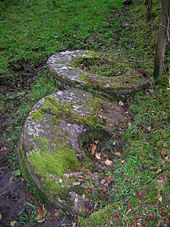- Millstone
-
For other uses, see Millstone (disambiguation).
Millstones or mill stones are used in windmills and watermills, including tide mills, for grinding wheat or other grains.
 Grinding maize in a working watermill, Thethi, northern Albania.
Grinding maize in a working watermill, Thethi, northern Albania.
The type of stone most suitable for making millstones is a siliceous rock called burrstone (or buhrstone), an open-textured, porous but tough, fine-grained sandstone, or a silicified, fossiliferous limestone. In some sandstones, the cement is calcareous.[1]
Contents
Types
Millstones used in Britain were commonly of two types:
- Derbyshire Peak stones of grey Millstone Grit, cut from one piece, used for grinding barley; imitation Derbyshire Peak stones are used as decorative signposts at the boundaries of the Peak District National Park. Derbyshire Peak stones wear quickly and are typically used to grind animal feed since they leave stone powder in the flour, making it undesirable for human consumption.
- French burrstones, used for finer grinding. Not cut from one piece, but built up from sections of quartz, cemented together with plaster, and bound with iron bands. French Burr comes from the Marne Valley in northern France.
In Europe, a third type of millstone was used. These were uncommon in Britain, but not unknown.
- Cullen stones (stones from Cologne) were quarried in the Rhine Valley near Cologne, Germany.[2]
In India, grinding stones (Chakki) were used to grind grains and spices. These consist of a stationary stone cylinder upon which a smaller stone cylinder rotates. Smaller ones, for household use, were operated by two people. Larger ones, for community or commercial use, used livestock to rotate the upper cylinder.
Runner stone
A runner stone is the upper of a pair of working millstones. The runner stone spins above the stationary bedstone creating the "scissoring" or grinding action of the stones. A runner stone is generally slightly concave, while the bedstone is slightly convex. This helps to channel the ground flour to the outer edges of the stones where it can be gathered up.
Patterning
The surface of a millstone is divided by deep grooves called furrows into separate flat areas called lands. Spreading away from the furrows are smaller grooves called feathering or cracking. The furrows and lands are arranged in repeating patterns called harps. A typical millstone will have six, eight or ten harps. The grooves provide a cutting edge and help to channel the ground flour out from the stones. When in regular use stones need to be dressed periodically, that is, re-cut to keep the cutting surfaces sharp.
Millstones come in pairs. The base or bedstone is stationary. Above the bedstone is the turning runner stone which actually does the grinding. The runner stone is supported by a cross-shaped metal piece (rind or rynd) fixed to a "mace head" topping the main shaft or spindle leading to the driving mechanism of the mill (either water or wind powered). The pattern of harps is repeated on the face of each stone, when they are laid face to face the patterns mesh in a kind of "scissoring" motion creating the cutting or grinding function of the stones.
Millstones need to be evenly balanced, and achieving the correct separation of the stones is crucial to producing good quality flour. The experienced miller will be able to adjust their separation very accurately.
 Millstones used in a grinder for olive oil extraction.
Millstones used in a grinder for olive oil extraction.
Idiom
A millstone around one's neck is a Biblical metaphor meaning a burden or large inconvenience one has to endure.
The phrase "show your mettle" is also said to come from milling. Millwrights, who would typically shape the stones during maintenance, would use a thrift and millbit (or mill bill), and the millbit would often break off small flecks of metal during use. Being made of iron, these pieces would enter the forearms of the millwright during the course of his work, and thus a large collection would show his continued employment and experience.[citation needed]
Ancient history
Neolithic and Upper Paleolithic people used millstone to grind grains, nuts, rhizomes and other vegetable food products for consumption.[3] These implements are often called grinding stones. They used either saddlestones or rotary querns turned by hand. Such devices were also used to grind pigments and metal ores prior to smelting.
Abandoned millstones at Drumcastle in Scotland.
See also
- Bedrock mortar
- Edge mill
- Querns
References
- ^ Bucksch, Herbert (1997). Dictionary Geotechnical Engineering, Vol. 1. Springer-Verlag. pp. 80. ISBN 978-3540581642.
- ^ "Peak District Millstones". Stephen N Wood. http://www.peakscan.freeuk.com/geology.htm. Retrieved 10 April 2010.
- ^ Revedin, A; Aranguren, B; Becattini, R; Longo, L; Marconi, E; Lippi, MM; Skakun, N; Sinitsyn, A et al. (2010). "Thirty thousand-year-old evidence of plant food processing". Proc Natl Acad Sci U S A 107: 18815–18819. Bibcode 2010PNAS..10718815R. doi:10.1073/pnas.1006993107. PMC 2973873. PMID 20956317. http://www.pubmedcentral.nih.gov/articlerender.fcgi?tool=pmcentrez&artid=2973873.
External links
Categories:- Milling terminology
- Grinding and lapping
- Food grinding tools
Wikimedia Foundation. 2010.






